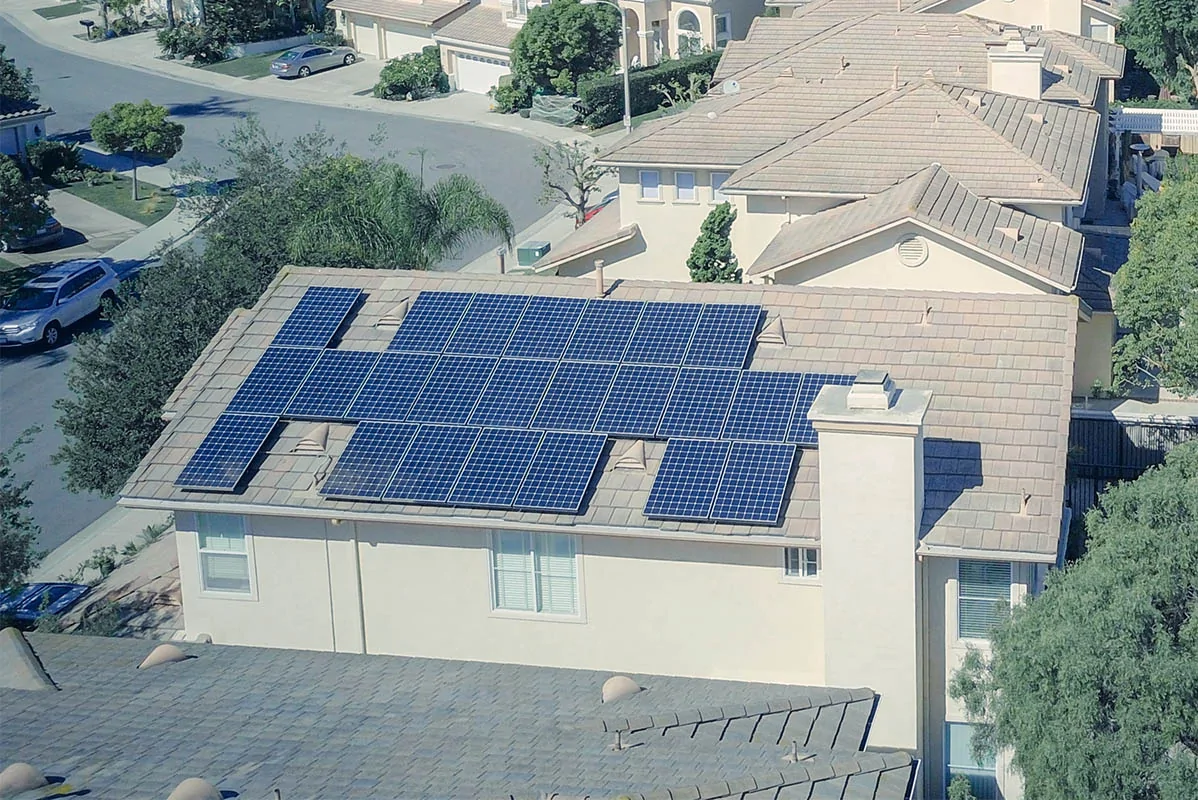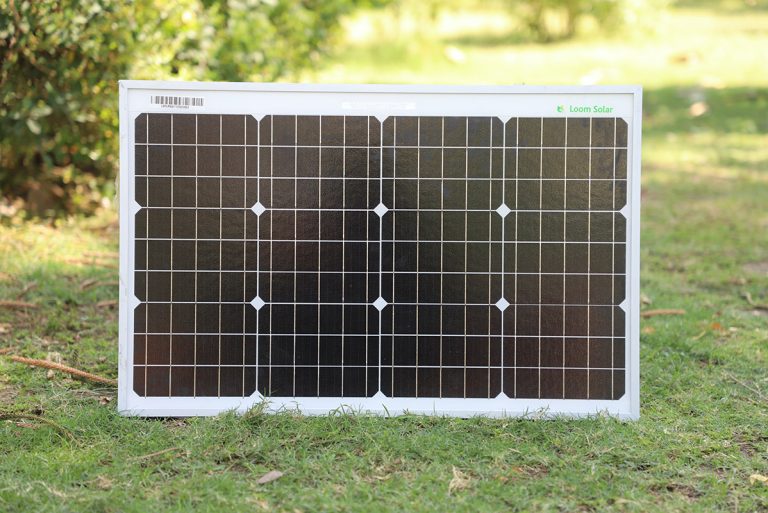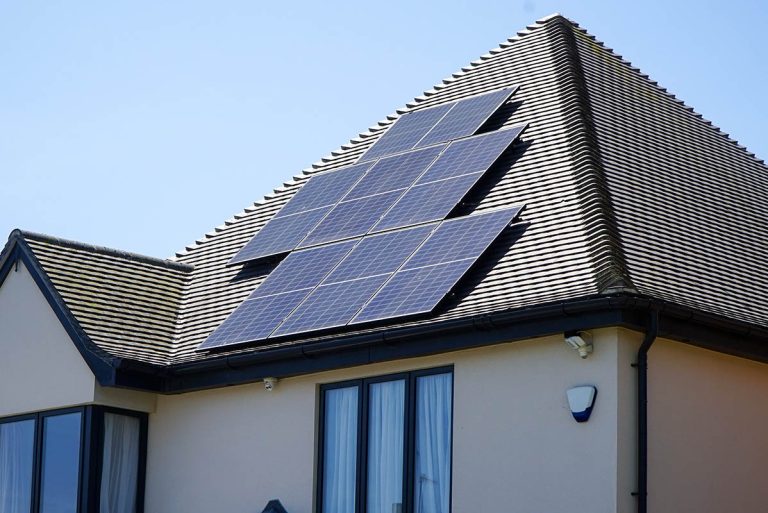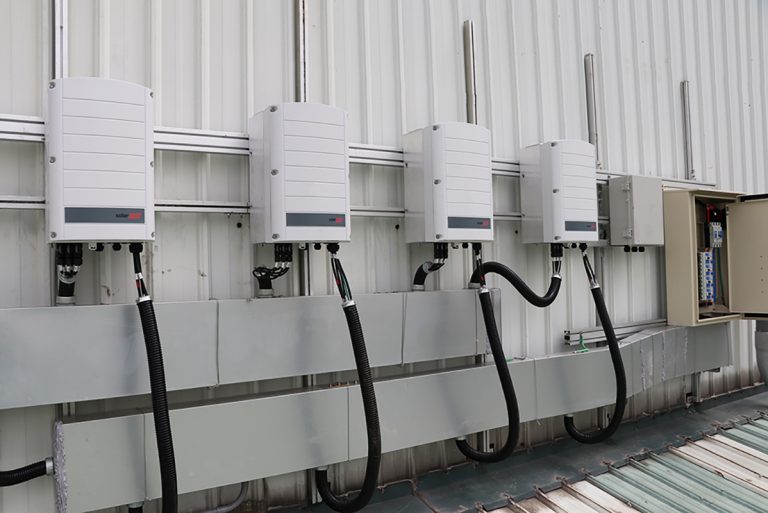Solar panel specification (data) sheets are full of a dizzying array of numbers about many things including solar panel size and weight. What do they all mean?
If you’re a homeowner or business owner looking to make the switch to renewable energy — and enjoy the substantial energy savings that come with it — it’s helpful to get comfortable spotting key information about solar panel size and weight from reading those spec sheets.
So, when solar companies present you with pages of mind-numbing calculations to prove to you why their proposal is the best, you’ll understand them better and choose the best one for you.
In this article, you’ll find out everything you need to know about solar panel size and weight. Sample calculations using solar panel size and weight for homes and businesses will help you estimate exactly what you need.
Plus, you’ll learn about various factors that directly impact the performance of your residential or commercial rooftop solar array. These are important to consider when planning out your solar setup size dimensions using solar panel size and weight so you’ll maximize solar power at the lowest cost.
There’s no surprise in learning that other data on the solar panel spec sheet (besides solar panel size and weight) are important when including those factors in a solar array performance assessment.
We got you covered on that, too.
Solar panel size and weight guide
Since the number of solar panels you need to meet your energy requirements is a major determinant of your upfront installation cost, knowing the size of the modules is critical to lowering your cost.
In other words, your goal in looking up the dimensions and figuring out how many panels you need to meet your energy requirements is to find the fewest number of panels that will suffice.
This is especially true if you have limited roof space, large energy demands, and/or a small budget.
In general, you want highly efficient, small panels to reduce costs.
Fortunately, solar module weight is not a huge factor in achieving this objective as long as you have a roof in good condition.
How big are solar panels?
When you look at a solar panel data sheet, go to the section titled Mechanical Properties, Mechanical Data, or something similar to find out how big solar panels are.
This information is often in tabular form. It may appear as a labeled diagram.
In a table, you will find solar module dimensions usually given as length times width times height (LxWxH) in millimeters (mm) or inches (in). Consider height to be the same as depth (thickness).
On a diagram, you can read the dimensions directly. They will be shown with double-headed arrows like this:

Usually, residential rooftop solar panels are approximately 65 inches tall, 40 inches wide, and 2 inches thick. In feet, that would be 5.4 ft. by 3.3 ft.
Commercial solar modules are usually slightly larger in length and width only.
However, with greater technological innovations in recent years, there is no longer a clear cut distinction between solar modules for private residences vs. those for businesses.
Because of all the changes in the solar world, it is no longer as simple as adding the dimensions of a greater number of individual solar cells making up each panel (usually each one is 6 in. by 6 in.) to a “residential” panel’s size to determine a “commercial” panel’s size.

Source: Wikimedia /
RoofjockeySince every manufacturer is different in how they present information on their data sheets, it’s also not clear whether the dimensions of the panel frame (if there is one) are included in the LxWxH measurements. (Usually, frames today are 1-2 in. wide.)
So, it’s always a good idea to ask manufacturers exactly how they size their panels. This is especially true if you have severe space restrictions.
Or, you may have local code regulations stipulating how much unobstructed space around the perimeter of a solar array you must have (for maintaining roof access during a fire).
The additional frame dimensions (if there are any) probably won’t enlarge your solar system too much, but it’s good to err on the safe side. Ask questions before signing a contract.
Solar panel size chart
The line between residential and commercial panels in terms of solar panel size (length and width) is blurred as the chart below illustrates.
This chart provides typical size dimensions of several representative solar panels of popular brands sold today using various types of solar technology.
Some solar companies will use the terms residential and commercial on their websites, but others will not.
So, when surfing the web, assume that panels designated as neither residential nor commercial could work for you.
In the cases of non-designated solar modules, it’s more important to examine the spec sheets to see how well particular panels will perform and how well they will fit on your roof or on your property as a ground-mount system according to the amount of solar power you wish to generate. (See below for more on calculating this.)
| Brand of Solar Panel | Panel category | Number & Type of Solar Cells | Dimensions (LxWxH in inches) |
|---|---|---|---|
| SunPower E-Series | Residential | 96 monocrystal-line | 61x41x2 |
| Trina Solar PC-05 | Residential | 60 multicrystal-line | 65x39x1 |
| LG NeON | Residential | 132, monocrystal-line | 74x41x2 |
| Mission Solar MSE PERC 72 | Commercial | 72 PERC monocrystal-line | 78x39x2 |
| XSunX XSC | Commercial | 96 CIGS Thin Film | 69x39x2 |
How much do solar panels weigh?
To find out how much solar panels weigh, consult the spec sheets again. The weight (in pounds or kilograms) should appear in the same table of mechanical information (or properties, data) where you found solar panel size dimensions.
Today, residential solar panels weigh approximately 42 pounds. Commercial solar panels weigh approximately 50 pounds. But again, there is no hard and fast rule nor an industry standard.
Here is a table of representative solar panel weights from popular brands.
| Brand of Solar Panel | Panel category | Weight (lbs.) |
|---|---|---|
| SunPower E-Series | Residential | 41 |
| Trina Solar PC-05 | Residential | 41 |
| LG NeON | Residential | 43 |
| Mission Solar MSE PERC 72 | Commercial | 48 |
| XSunX XSC | Commercial | 56 |
Can my roof support solar panel weight?
Homeowners or business owners may think that 20+ solar panels will weigh too much on their roofs and compromise its integrity. Surprisingly, this is not true in most cases.
The reason why most roofs can support a solar array is that the total weight is evenly distributed over a large surface area. This means there is little additional weight per square foot.

The Insurance Institute for Business & Home Safety publishes a summative roof guide and regularly updates it. It contains information on codes and standards from many of the major international and national regulatory organizations which establish building codes and standards.
In that document, there are links to the major organizations stating that typical asphalt shingle or wooden roofs can bear up to 20 ft. per square foot. Clay tiled or metal roofs may hold up to 27 lbs. per square foot.
As a ballpark guesstimate, if your solar array was designed to house 20 panels weighing 43 lbs. each, the system would weigh 43 x 20 = 860 lbs. Mounting hardware adds more weight depending on materials. Usually, lighter aluminum is the material of choice.

For a 20-panel array, the hardware may add up to 200 lbs. to the combined weight of all the solar panels. This varies, of course, based on the size of the solar panels as well as the hardware material.
So, those 20 modules spread over an estimated roof area of 400 square foot (see example below), subject your roof to the equivalent of (860 + 200) / 400 = 2.65 lbs. per square foot.
This is well below the maximum acceptable load (20 ft.2) for a typical roof.
However, if your particular solar panels were so extremely efficient or powerful that you needed only one or two small but heavy modules to meet all of your energy needs, this standard would not apply. Then you’d have to consider the effect of a concentrated load on one small area of your roof.
Building codes are different for concentrated loads. Then you’d need a certified contractor or mechanical engineer to sign off on your proposed array first to avoid a hole in your roof due to a concentrated load.
On the other hand, if your roof is in poor shape, very old, or structurally damaged in any way, it is a good idea to consult with an independent engineer or contractor first for peace of mind before you install a setup of any solar panel size or weight to avoid an accident.
For more information, check out our post on the solar panel roof load calculator.
Roof age and timing of a rooftop solar installation
Another consideration regarding the installation of a solar array no matter the solar panel size or weight is the age of the roof’s shingles. If they’re approaching their functional limit, it would be more economical and easier to replace the shingles before installing a solar array.
This way, before the panels’ normal lifespan (25+ years) is reached, you won’t need to uninstall the panels in order to replace the shingles when they need to be, then reinstall the solar array later on a brand new roof.
How many solar panels do you need?
To figure out how many solar panels you need, it’s essential to know two things:
- Your average energy requirements
- How much of that demand you want met by solar energy versus the public utility.
Calculating your average energy requirements
To determine how much energy you require, add up your electricity usage — stated on electric bills — over the past year. The value is expressed in kilowatt-hours (kWh).
As a rule of thumb, the average household in the United States in 2020 used approximately 11,000 kWh of electricity annually. That works out to be about 900 kWh per month.
Determining how much solar energy you want to meet your total energy needs
If you want to get 100% of your electricity from your solar system, you need to factor in the expected loss of power production due to weather variability. Then add to your actual energy usage when doing the calculations.
This way, you’ll never fall short on electrical power.
For example, it’s possible to lose up to 90% of energy production on cloudy days. Solar “soiling” from dust and other particle pollution may cause an additional 7% drop in energy output in the United States.
So, to figure out the size of the solar system that will meet your needs given the energy losses you will encounter due to variable weather, adjust your energy demand to be approximately 25% higher than what it actually is.
This way, you’ll decrease the impact of low energy production weather conditions on your calculations and never be without power.
So, using the national average: 900 kWh x 1.25% = 1,125 kWh per month. (You need this value for the next step.)
Since this value is only an average, there will be some months when you use less, and some months where you use more.
To avoid overproducing, it is imperative that:
- You’re connected to the grid and can send excess energy back through net metering for energy credits that you redeem later when you need more energy than what you produce and/or
- You have a battery backup to store unused energy that you consume later when you need it.
If neither of those conditions apply to you, you definitely want to use your solar array to generate less than what you require so you’ll never overproduce. But, you should still take into account the weather-related losses by adding 25%.
So, for example, if you only want your solar array to produce half of your home’s energy requirements, perform a calculation similar to the one above.
But, you’d use 75% (50% + 25%) of 900 kWh (the national average) or whatever your home’s monthly average is: 900 kWh x 0.75 = 675 kWh.
Use this value to figure out the size of your solar array.
Determining how much solar energy you will likely generate
To determine how much solar energy you will generate, you need to figure in the number of hours of direct sunlight you get everyday.
This number varies depending on many factors, including your location, the tilt of your panels, and their orientation to the sun. (More on these below.)
The best way to get the number of direct sunlight hours is to use an online calculator called PV Watts.
A simpler alternative is to consult this map:
It could be 3-6 hours per day, but usually it’s 4-5 hrs./day in the continental USA.
Calculating your solar array size in kilowatts (kW)
Finally, with the numbers you calculated above, you can figure out the solar array size you need in watts every month.
Solar array (kW) = Monthly electric usage / (direct sun hours x 30)
For the example above: 1,125 kWh / (5 hrs. X 30) = 7.5 kW
So, for the average household that wants 100% of its energy created by the sun, their rooftop solar array must be 7.5 kW in size.
Calculating your solar array size in terms of the number of panels
In this step, you will find out how many solar panels your 7.5 kW solar system requires. Knowing their dimensions, you can then figure out the roof area you need to support them.
Solar panels are rated in watts (W). For a home or business, they typically range from 100 W to 400 W. For this example, assume you’re interested in a 375 Watt solar panel.
Since the solar system size found in the preceding step is expressed in kilowatts and 1 kilowatt equals 1,000 watts, the equation becomes:
Number of solar panels = Array size x 1,000 / panel wattage
Using the numbers found here: 7.5 kW x 1,000 / 375 W = 20 panels
So, you’d need an array of 20 solar panels, each one rated at 375 Watts to meet all of your energy needs.
Computing the roof area of your solar array
The architecture of your particular roof will determine the placement of the solar panels.
In this example, 20 modules could be mounted in several different ways such as:
- Two rows of ten
- Five rows of four
- Four rows of five

Assuming panel dimensions (in inches) of 65x40x2, a 5×4 array has the area: (65 x 5) x (40 x 4) = 325 in. x 160 in.
Expressed in feet: 325 / 12 = 27 ft.
160 / 12 = 13.3 ft.
So the rectangular array will be 27 ft. long and 13.3 ft. wide with a 2 in. thickness. Its area = 27 x 13.3 = 359 sq. ft.
Businesses calculating the roof area needed for a solar system would perform similar calculations using their own (probably larger) numbers.
Factors that influence solar production & the number of solar panels needed
As mentioned previously, there are several factors that influence how much solar energy your rooftop solar array will actually produce. These factors, in turn, partly determine the number of solar panels you need.
Ultimately, it’s your roof size which will dictate what the final result will look like.
The United States Environmental Protection Agency (EPA) developed a helpful document titled Solar Photovoltaic Specification, Checklist, and Guide. It discusses many of the factors that influence solar energy production.
Here are some of the pertinent points from that Guide you need to take into account to maximize the success of your home or commercial solar project:
- Assume 500 sq. ft. for a 5 kW array (1 kW/100 sq. ft.). If using energy-efficient appliances, a smaller area will suffice.
- Roofs situated directly (due) south receive the most direct sun. This is the best orientation. If the roof is more than 45 degrees off from due south, energy production will be very diminished. You should consider a ground mount system instead.
- The tilt angle of the array should match the array’s geographic latitude in degrees. Other sources adjust this value slightly. This is referred to as the inclination of the solar array.
- Conduct a solar shading study using a sun path tool such as Solar Pathfinder or Solmetric SunEye to determine the impact of shading (if any) on energy production.
Other factors that influence solar panel energy production
Besides these factors, you should take into consideration the efficiency of solar modules on the market today to convert solar energy to electrical energy.
Today, the efficiency ranges from 8-12% for first-generation thin film panels. It goes up to 23-25% for PERC or CIGS.
Monocrystalline panels may achieve a 18-22% efficiency.
Also, solar modules with small temperature coefficients close to zero (also on spec sheets) perform better in hot regions.
Note that all panels decrease efficiency over time through natural degradation rates, but some are better at maintaining optimal functioning compared to others.
This information is also listed on solar panel spec sheets.
Carefully review warranty terms to estimate a panel’s efficiency over its projected lifespan and compare with the warranties of other panels you’re considering.
The longer the warranty for power production, the better the panel in most cases.
Key takeaways on solar panel size and weight
When considering rooftop solar for your home or business, it’s important to consider solar panel size and weight.
If you’re limited on roof space, have shading issues or sub-optimal orientation, choosing more efficient panels is better. They can produce greater wattage for their (typically) smaller size. This means you won’t need as many to get the same energy output as less efficient (and possibly larger) panels.
On the other hand, with a large usable roof area, you can sacrifice high efficiency — and save on startup costs — when you buy larger panels at a lower cost per panel. You’ll enjoy the same energy output as fewer, higher-efficiency solar modules would provide.
If you’re a business with extensive roof space, cheaper thin film panels that take up a lot of space may serve you well.
By using information from solar panel spec sheets about solar panel size and weight to your advantage, it’s easy to design a solar array that will perform well at less cost to you no matter your specific situation and needs.















![Eco-Worthy Solar Panel Review 2024 [Includes Buyer’s Guide]](https://greencoast.org/wp-content/uploads/2019/02/Eco-Worthy-Review-and-Buying-Guide-e1574180788859.jpg)